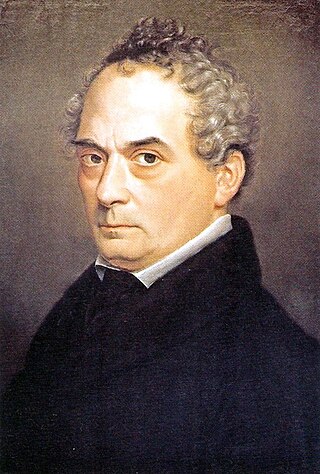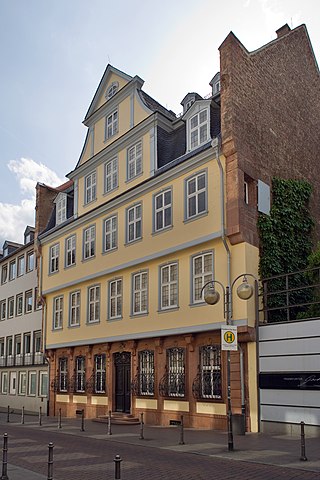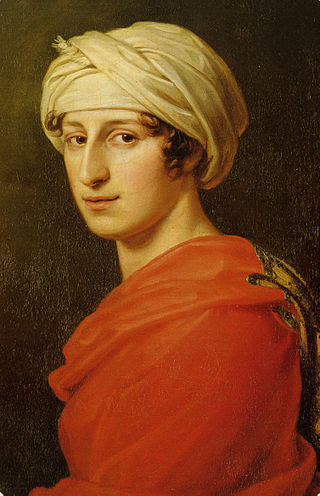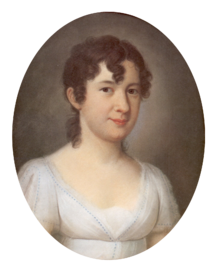
Clemens Wenzeslaus Brentano was a German poet and novelist, and a major figure of German Romanticism. He was the uncle, via his brother Christian, of Franz and Lujo Brentano.

Goethe University Frankfurt is a public research university located in Frankfurt am Main, Germany. It was founded in 1914 as a citizens' university, which means it was founded and funded by the wealthy and active liberal citizenry of Frankfurt. The original name in German was Universität Frankfurt am Main. In 1932, the university's name was extended in honour of one of the most famous native sons of Frankfurt, the poet, philosopher and writer/dramatist Johann Wolfgang von Goethe. The university currently has around 45,000 students, distributed across four major campuses within the city.

Bettina von Arnim, born Elisabeth Catharina Ludovica Magdalena Brentano, was a German writer and novelist.

Heidelberg Castle is a ruin in Germany and landmark of Heidelberg. The castle ruins are among the most important Renaissance structures north of the Alps.

The Goethe House is a writer's house museum located in the Innenstadt district of Frankfurt, Germany. It is the birthplace and childhood home of German poet and playwright Johann Wolfgang von Goethe. It is also the place where Goethe wrote his famous works Götz von Berlichingen,The Sorrows of Young Werther, and the first drafts of Urfaust. The house has mostly been operated as a museum since its 1863 purchase by the Freies Deutsches Hochstift, displaying period furniture and paintings from Goethe's time in the house.

Johanna Christiana Sophie Vulpius von Goethe was the longtime lover and later wife of Johann Wolfgang von Goethe.

"Gingo biloba" is a poem written by the German poet Johann Wolfgang von Goethe. The poem was published in his work West–östlicher Divan, first published in 1819. Goethe used "Gingo" instead of "Ginkgo" in the first version to avoid the hard sound of the letter "k".
Theodor Creizenach was a German Jewish poet and historian of literature. He was the son of Michael Creizenach.

The Bethmann family has been remarkable for the high proportion of its male members who succeeded at mercantile or financial endeavors. This family trait began in medieval northern Germany and continued with the Bethmann bank, which Johann Philipp Bethmann (1715–1793) and Simon Moritz Bethmann (1721–1782) founded in 1748 and soon catapulted into the foremost ranks of German and European banks. Even after the bank's sale in 1976, there are Bethmanns engaged in commercial real estate and forestry in the 21st century.

Johann Wolfgang von Goethe was a German polymath and writer, who is widely regarded as the greatest and most influential writer in the German language. His work has had a profound and wide-ranging influence on Western literary, political, and philosophical thought from the late 18th century to the present day. Goethe was a German poet, playwright, novelist, scientist, statesman, theatre director, and critic. His works include plays, poetry and aesthetic criticism, as well as treatises on botany, anatomy, and color.

Georg Ludwig Kriegk was a German historian and archivist born in Darmstadt.

Antonie Brentano, born Johanna Antonie Josefa Edle von Birkenstock and known as Toni, was an Austrian philanthropist, art collector, arts patron, and close friend of Beethoven, being the dedicatee of his "Diabelli" variations.

Catharina Elisabeth Goethe, born Catharina Elisabeth Textor, was the mother of German playwright and poet Johann Wolfgang von Goethe and his sister Cornelia Schlosser. She was also known by the nickname Frau Aja and the title Frau Rat.
Bernard von Brentano was a German writer, poet, playwright, storyteller, novelist, essayist and journalist.

West–östlicher Divan is a diwan, or collection of lyrical poems, by the German poet Johann Wolfgang von Goethe. It was inspired by Goethe's readings of the Persian national poet Hafez.

Cornelia Friederica Christiana Schlosser was the sister and only sibling of Johann Wolfgang von Goethe who survived to adulthood.

Henrietta Catherine Agnes of Anhalt-Dessau was a princess of Anhalt-Dessau by birth, Dean of Herford Abbey and by marriage Baroness of Loën.

Anna Elisabeth "Lili" Schönemann was the daughter of a Frankfurt banker. In August 1778 she became engaged to, and then married, another banker, Bernhardt Friedrich von Türckheim, and her name became "Lilli" von Türckheim. Before that happened, however, between January and October 1775 she was engaged in an intense love affair with Johann Wolfgang von Goethe, described in one source as his "first great love". Memories lingered: towards the end of his life, conversing with his young friend Johann Peter Eckermann, Goethe recalled that he had loved Lili profoundly and had never been so close to happiness as he was with her. She featured repeatedly in his written work, identified simply as "Lili" or, according to some sources, as "Lilli".

Louise van Panhuys née von Barckhaus of Wiesenhütten was a German botanical artist and landscape painter.

Baroness Ottilie Wilhelmine Ernestine Henriette von Goethe was a German socialite and the daughter-in-law of Johann Wolfgang von Goethe.


















